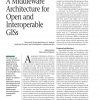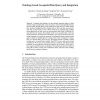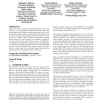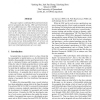AISS
2010
14 years 3 months ago
2010
Disaster prevention and management is a complicated task that often involves a tremendous volume of heterogeneous data from various resources. With its dynamic and distributed nat...
IEEEMM
2002
14 years 6 months ago
2002
an abstract model for information sharing and integration and use it to develop an architecture for building open, component-based, interoperable systems. A geographic information ...
GIS
2006
ACM
14 years 6 months ago
2006
ACM
Geospatial data is often used to predict or recommend movements of robots, people, or animals ("walkers"). Analysis of such systems can be combinatorially explosive. Eac...
GISCIENCE
2008
Springer
14 years 7 months ago
2008
Springer
Geospatial data sharing is an increasingly important subject as large amount of data is produced by variety of sources, stored in incompatible formats, and accessible through diffe...
GEOINFO
2007
14 years 7 months ago
2007
The Internet creates an environment suitable to spatial data share, allowing the users to transmit, visualize, manipulate and interact with them. This environment not only allows n...
ACMACE
2008
ACM
14 years 8 months ago
2008
ACM
The games with a purpose paradigm proposed by Luis von Ahn [9] is a new approach for game design where useful but boring tasks, like labeling a random image found in the web, are ...
GIS
2009
ACM
14 years 9 months ago
2009
ACM
Geospatial information (GI) constitutes a significant portion of available data and are a key factor in planning and decision-making in a variety of domains,such as emergency man...
APSCC
2006
IEEE
14 years 10 months ago
2006
IEEE
This paper explores combining OGC and Grid technologies for geospatial data sharing. OGC and Grid technologies have different focuses: OGC technologies focus more on interface spe...
INFOVIS
1999
IEEE
14 years 10 months ago
1999
IEEE
We have developed a technique, Aggregate Towers, that allows geospatial data to be visualized across a range of map scales. We use a combination of data aggregation algorithms and...
GIS
2009
ACM
14 years 10 months ago
2009
ACM
Harnessing the potential of today’s ever growing and dynamic geospatial data requires the development of novel visual analysis interfaces, tools and technologies. In this paper,...




